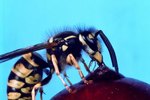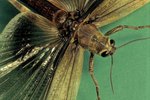
Figs and fig wasps have a special relationship that is essential to their mutual survival. The fig provides a home for the wasp and the wasp provides the pollen that the fruit needs to ripen. The insect's life cycle begins when a tiny female wasp enters a fig and begins laying eggs inside it.
Sending a Signal
Figs contain tiny flowers that must be pollinated in order for the fruit to ripen. They produce a strong scent when they’re ready for pollination, which draws a female wasp, known as the fig’s queen wasp. Once she smells the aroma, she flies to the fig from her current home in another fig and wiggles her way into a very small opening at one end of the fruit. The opening is so small that her wings and parts of her antennae break off as she enters. The wasp will never leave and won’t need her wings again.
Laying Eggs
The female immediately begins laying eggs in the flowers contained within the fig and spreading the pollen that the fig needs to ripen. The pollen comes from the fig that previously served as her home. The flowers that contain wasp eggs won’t reach maturity. Fortunately the wasp pollinates the entire fig, not just the flowers in which she lays eggs, and the flowers that don’t contain eggs will mature. Laying eggs is the female wasp’s entire purpose in life and she dies after she finishes. The Ecological Society of America notes that the queen’s body is absorbed by the fig and used for nourishment.
Maturation and Mating
The eggs the queen laid become wormlike grubs before growing into mature fig wasps. The grub is the larval stage of the wasp. During this stage, the grub gradually takes on the features of an adult wasp. Males reach maturity first. They have dark heads and clear amber bodies, but don’t have wings because they will never leave the fig. Females are larger and have dark heads and dark bodies. Once the female wasps reach maturity, they mate with the males.
Role of Female Wasps
After mating, male wasps create a hole in the fig that will allow the female wasps to leave. Mating and hole-digging are the chief duties of the male wasps, and they die after they complete these tasks. The female wasps still have an important role to fulfill, as they are responsible for creating future generations of fig wasps and pollinating a new fig. They collect some of the pollen from the fig in their pouches or on their bodies after they mate. Once they smell the aroma from a fig ready to be pollinated, they leave and begin a new life cycle in the new fig.
References
Photo Credits
-
Jupiterimages/Comstock/Getty Images
Writer Bio
Working at a humane society allowed Jill Leviticus to combine her business management experience with her love of animals. Leviticus has a journalism degree from Lock Haven University, has written for Nonprofit Management Report, Volunteer Management Report and Healthy Pet, and has worked in the healthcare field.




